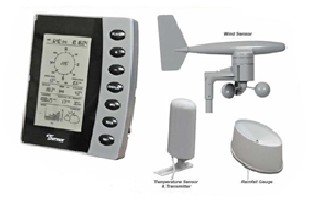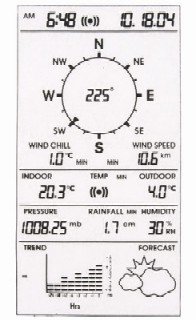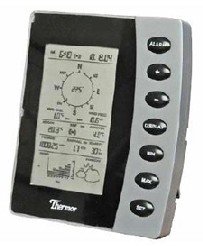|
The Thermor DG950 Wireless Home Weather Station ReviewedThe Thermor DG950 appeared in 2004 as a relatively cheap, fully functional home weather station. Relatively cheap, that is, if you were, or are, a Canadian, because the Thermor is a Canadian product. Prices there seem to vary depending on specials from $69 to $100CAN, but once borders are crossed the price seems to double or more. The external sensors are battery powered, although an AC adaptor is an optional extra. Wind speed and direction, and rainfall sensors link to the temperature unit, which also acts as the transmitter. The radio range is good, at about 300 feet or 100m. Updates are transmitted at 30-40 second intervals.

The indoor receiver can be wall mounted or stand alone, and can display in either imperial of metric units, except air pressure which is given in millibars. The display is clear and well designed, but some people have had problems in finding the right angle to observe it. The screen displays date and time, wind chill, maximum and minimum values, air pressure trend over the past 24 hours, and provides a forecast for the next 12 hours based on the previous 72 hour history. As for specifications, accuracy listed first;
So far there is no way to connect the Thermor to your computer. Click Here For Your Free 20 Page Report on Solving Comparisons To Other Home Weather StationsSo much for the description. But how does it compare to other home weather stations?
Firstly, a very good rule with weather stations is that you get what you pay for. If you can spare $300 - $400 or so you can afford a basic Davis Vantage Vue, and you can expect pretty much trouble free performance with excellent service and backup. Drop down to the $200-$300 range and you are looking at the top of the La Crosse and Oregon ranges. There are some questions with reliability here, although most problems can be overcome with some preventative maintenance and regular checks on the condition of moving parts and electronic connections. Both companies have been a little below par with customer service, but perhaps they've fixed that now. Overall, however, with a bit of care you can acquire a good reliable unit which will give you years of useful information and is computer compatible. The Thermor falls into a lower price bracket, particularly in Canada, and has had problems with both the power supply and quality control of both the outside recorders and the interior base unit. Quality control has been to a large extent overcome by very good customer service, including prompt replacement of defective parts, even where the defect may lie in customer set up rather than faulty equipment. But at least in the early stages, defects seemed to be too common, and even when replacement is fast, it still means the owner is without a weather station for a while. Now Thermor has been working on the problems, and the current stock should be more reliable. But perhaps care should be taken with used stations.

A minor quibble is with the rain collector, which is a rather shallow oval basin. This could create problems with rain splashing out during moderate to strong windy conditions, resulting in a low reading. Again location of the unit would minimize this problem. But the real difficulty with the Thermor DG950 is in its power usage. The external transmitter runs on AA batteries, with lithium batteries recommended for cold conditions. These batteries seem to have very short lifespans, particularly in cold conditions, where replacement is required at fortnightly, or even weekly intervals. I imagine this would become very annoying after a while. So far solar power is not available, although the more technically adept owners may be able to fit their own. An AC adaptor is now available with recent models, and probably overcomes the problem, but rather defeats the purpose of a wireless weather station. ConclusionsSo overall, if you can get it for a Canadian price, and get good service out of the AC adaptor, then it's probably not a bad starter unit, and may develop into a good weather station with a few company initiated modifications. But at around the $200 mark, it may be best to look carefully at the Oregon or La Crosse range for not much more. Thermor should be credited for trying to develop an inexpensive, full function weather station, and have done their best to look after their customers. But at this stage of its development, there appear to be better value weather stations around. The Thermor DG950 also appeared under the brands Bios and National Geographic, but they appear to be no longer available. Here's where to go to find out more about Home Weather Stations and related instruments, including some alternatives to the Thermor weather station. Thermor and Bios weather stations occasionally turn up on online auctions in the US and Canada, but although I regard eBay as a good place to find well priced, fully guaranteed and supported weather stations, I would suggest caution with Thermor. If you decide to buy one, go for the latest model. Even new Thermors may not be the latest model, and a used station would be a high risk purchase.
Back to the Top, or return to the Home page. Click Here For Your Free 20 Page Report on Solving
Last update 12/05/2011
|




 Well the jury's still out on that question.
Well the jury's still out on that question.